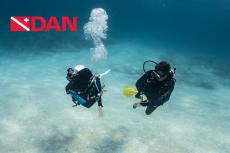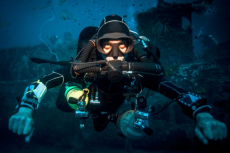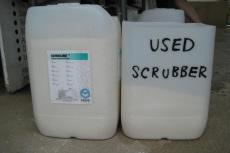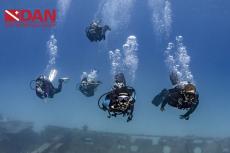Understanding the Future of Decompression Risk
Decompression stress is a tricky topic to understand. From early in our diving careers, we are taught to think of decompression sickness (DCS) as binary—you either have symptoms or you do not.
Being tired or achy after a long dive, unplanned exertion at depth or a change in decompression planning is often not considered very seriously; if you do not have symptoms, the prevailing thinking is to not worry about it. Despite the way divers have operated for decades, researchers at the forefront of decompression research are pushing hard for greater consideration of the factors that contribute to DCS risk—factors, which combined, create a total picture of our risk.
This holistic picture of DCS risk is called decompression stress—it is a combination of environmental, physiological and diver-specific factors. While excellent in theory, this conceptualization requires a more thorough understanding of bubble mechanics than we currently possess. Connecting decompression stress to real DCS numbers depends on a thorough understanding of how bubbles form in the body, what they do and when they cause symptoms, and that is something we just do not have yet.
Virginie Papadopoulou, Ph.D., a researcher at the University of North Carolina, is working on such an understanding of bubble mechanics. Her work deals with the clinical applications of bubbles in ultrasound-targeted drug delivery, bubble formation in divers and correlation of bubble counts with DCS risk.
Research from her lab has indicated that our inability to correlate a diver’s postdive bubble count (the number of bubbles observed in their body) with DCS risk may hinge on the technology we use to view those bubbles.
Papadopoulou specializes in ultrasound imaging techniques and has proposed that using more advanced ultrasound imaging to count not just the typical range of bubble sizes, but microbubbles and nanodroplets (bubbles on the order of 1-10 micrometers) may yield a more linear correlation between bubble count and actual DCS risk.
Microbubbles and bubble counts
These microbubbles have previously gone undetected, but recent projects using contrast ultrasound have shown that including microbubbles in post dive bubble counts results in a signal increase (indicative of bubble populations in this type of ultrasound imaging) in divers who were previously considered “bubblers” as well as those considered “nonbubblers” when subjected to tradition ultrasound imaging.
Some of these divers, imaged with traditional b-mode sonography, may bubble equally but in sizes that could not be imaged, leading researchers to conclude that they did not bubble at all. Similarly, divers that bubbled significantly and in sizes that could be traditionally imaged would appear to be “bubblers” while asymptomatic, which pushed research even away from an accurate relationship between bubble count and DCS risk.
Looking at the bigger picture
In addition to this revolution in imaging technology, many researchers, Papadopoulou included, are working toward understanding DCS in a linear model. Rather than noting just which divers had DCS and which did not, they are advocating a more complete understanding of each individual diver and their profiles and comparing this information to their dive outcomes.
The individual contributions to total DCS risk have yet to be determined, but understanding the effect of hydration, ascent rate, water temperature, exercise, body composition and more, and combining that with accurate bubble counts paints a clearer picture of decompression risk as a whole.
Considering these risk factors in light of not only reported DCS symptoms but within a broader picture of fatigue, aches and other symptoms frequently dismissed as subclinical or as caused by other factors (such as exertion, sunburn, etc.) may help researchers find new ways to understand the risks we face while diving and how to better keep divers safe.
It is hard to know even now if we have a complete picture of bubble count or any other physiological change after a dive. Papadopoulou and others are actively working toward controlled studies to understand microbubbling and other factors that contribute to DCS risk, but their work is not yet ready for wide- spread application.
We can look forward to a field of young academics interested in both the clinical applications of bubble science and gaining a more thorough understanding of how bubble counts affect our risk as divers. The light at the end of the tunnel appears to be personalized decompression algorithms, tailored to our individual physiologies and dive profiles.
Whether we will see these in the next year, five years or decade remains to be seen, but understanding the process as it progresses may provide divers with new best practices to minimize their risk, particularly as they push the limits of what recreational divers are capable.
For more information, visit: DAN.org
- Log in to post comments




































































































